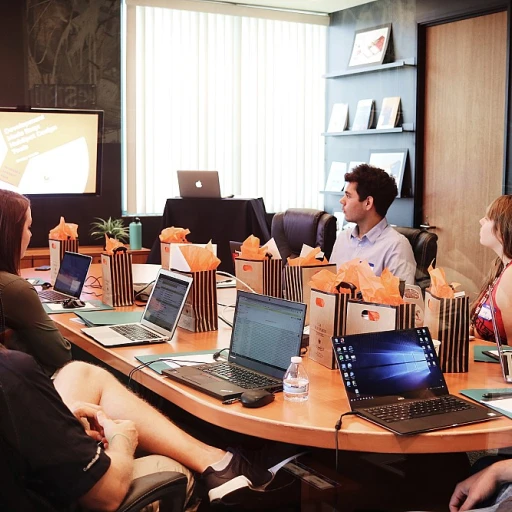
Defining Job vs Career
Understanding the Core Concepts
When diving into the world of employment, it's crucial to grasp the fundamental differences between a job and a career. While these terms are often used interchangeably, they represent distinct concepts in the professional landscape.
Job: The Short-Term Perspective
A job is typically viewed as a short-term engagement, primarily focused on earning a financial income. It often involves specific tasks or responsibilities that are part of a larger organizational structure. People usually take on jobs to meet immediate financial needs or to gain initial work experience. Jobs can be stepping stones that help individuals acquire the necessary skills and training for future opportunities.
Career: The Long-Term Journey
In contrast, a career is a long-term professional journey that encompasses a series of jobs and experiences, all contributing to one's professional growth and development. Careers are often aligned with personal goals and aspirations, offering opportunities for advancement and professional development. They require a commitment to continuous learning and skill enhancement, often involving education and training to achieve long-term career goals.
Choosing the Right Path
Deciding between a job and a career involves understanding one's professional goals and the level of commitment one is willing to invest. While jobs can offer immediate financial benefits, careers provide a structured path for long-term growth and job satisfaction. For those seeking to build a meaningful career, focusing on professional development and setting clear career goals is essential.
For more insights into how literature can provide a deeper understanding of professional dynamics, explore this comprehensive guide.
The Role of Employee Feedback in Career Development
The Influence of Feedback on Career Growth
Understanding the difference between a job and a career is crucial for anyone looking to advance in their professional life. While a job might be seen as a short-term engagement, a career is a long-term journey that involves continuous professional development and growth. Here, employee feedback plays a pivotal role in shaping one's career path.
Feedback is not just about identifying areas for improvement; it's a tool for career development. When employees receive constructive feedback, they gain insights into their skills and experience, helping them align their career goals with the organization's objectives. This alignment is essential for both personal satisfaction and professional growth.
Feedback as a Catalyst for Professional Development
Feedback helps employees understand their strengths and weaknesses, providing a roadmap for education and training. By identifying areas that need improvement, employees can seek out opportunities for education and training that will enhance their skills and prepare them for future roles. This proactive approach to career development ensures that employees are not just working towards short-term financial gains but are also investing in their long-term professional success.
Moreover, feedback can highlight potential career paths within the organization, encouraging employees to explore different roles and responsibilities. This exploration is crucial for choosing a career that aligns with one's interests and aspirations, ultimately leading to greater job satisfaction.
Incorporating feedback into the work life of employees can also foster a culture of continuous improvement. As employees receive regular feedback, they become more engaged and motivated, knowing that their efforts are recognized and valued. This engagement is key to maintaining a productive and harmonious workplace.
For more insights on how modern technology can enhance workplace dynamics and facilitate effective feedback, you can explore enhancing workplace dynamics with modern office technology.
Common Challenges in Employee Feedback
Confronting Challenges in Employee Feedback Systems
Navigating the path from short-term job satisfaction to long-term career goals often involves dealing with various challenges in the realm of employee feedback. A significant obstacle in the arena of professional development is the apprehension that often accompanies receiving constructive criticism. Many people struggle with differentiating between feedback and personal criticism, which can lead to a defensive stance that hinders growth and development. Moreover, the lack of clarity in feedback can cause confusion, leaving employees unsure of how to align their work and skills with their professional goals. In some cases, the feedback might not take into account the individual’s career path or the specific career development needs, leading to generalized suggestions that fail to support personal growth. Here are some common challenges encountered in the feedback process:- Ambiguity in Feedback: When feedback lacks specificity, it becomes challenging for individuals to translate this information into concrete actions that contribute to career development.
- Cultural Differences: Diverse workplaces might encounter barriers where different career paths are influenced by varying cultural interpretations of feedback. What is intended as constructive in one culture might be perceived as negative in another.
- Emotional Response: Emotional responses can cloud the judgment required to objectively assess and implement feedback effectively. This emotional hurdle can be detrimental to achieving long-term career satisfaction and professional growth.
Strategies for Effective Feedback Utilization
Using Feedback for Professional Growth
Developing a comprehensive approach towards utilizing feedback effectively can significantly impact your career journey. When feedback is systematically utilized, it fosters both short-term job satisfaction and long-term career development. Here's how you can align feedback with your professional growth:- Set Clear Career Goals: Acknowledging your career goals is paramount in tailoring feedback to your needs. It empowers individuals to focus on specific skills and areas that require improvement, contributing to a more directed approach in a job career path.
- Embrace Continuous Learning: Feedback should be perceived as a learning tool. Use feedback to identify gaps in knowledge and skills, guiding you towards necessary education and training opportunities. This proactive stance facilitates professional development over time.
- Seek Diverse Perspectives: Engaging with feedback from multiple sources provides a holistic view of your work performance. Different perspectives help in constructing a balanced understanding of your strengths and areas needing enhancement, essential for both job and career paths.
- Reflect and Act: Reflection is crucial in transforming feedback into actionable insights. Take the time to reflect on feedback received, then devise a plan to implement changes in your work life, ensuring alignment with your long-term career path.
- Track Progress Over Time: Regularly track your progress in response to feedback. This tracking not only demonstrates professional growth but also signals commitment to improvement, enhancing job satisfaction and opening new career opportunities.
The Impact of Feedback on Job Satisfaction
The Positive Influence of Feedback on Work Satisfaction
Understanding the difference between a job and a career is crucial when assessing the impact of feedback on job satisfaction. Feedback serves as a cornerstone for personal and professional growth by highlighting areas for improvement and acknowledging accomplishments. But how exactly does feedback elevate one's experience at work? Firstly, feedback provides clarity on expectations and aligns individual goals with organizational objectives. This understanding helps employees feel more connected to their work, enhancing job satisfaction and aligning with their long-term professional development. Moreover, when feedback is utilized effectively, it can lead to increased opportunities for skill development and career advancement. Receiving constructive input motivates individuals to enhance their capabilities, pursue further education or training, and explore new career paths. This active engagement in personal growth fosters a sense of satisfaction, knowing one is progressing toward long-term career goals. Employees who receive regular, constructive feedback often report feeling more valued within their organization. This sense of recognition and appreciation significantly boosts morale and work-life balance, making the job more fulfilling. Feeling acknowledged can also lead to a better understanding of the organization's vision, promoting a cohesive and cooperative work environment. In conclusion, feedback, when delivered thoughtfully, can dramatically improve job satisfaction, paving the way for meaningful career development and a sense of purpose in one’s professional journey. Engaging in this feedback loop not only benefits the individual but also enhances the overall productivity and culture of the workplace.Creating a Feedback-Friendly Workplace Culture
Fostering a Workplace Where Feedback Thrives
Creating a feedback-friendly workplace culture is critical for both individual and organizational development. This culture not only aids in navigating the differences between a job and career paths but also enhances professional growth, contributing significantly to long-term career satisfaction. When a work environment supports open communication, it empowers employees to improve their skills, pursue education and training opportunities, and align their career goals with organizational objectives.- Encourage Open Communication: Establishing a transparent communication channel enables employees to express their ideas, concerns, and feedback openly. Over time, this practice fosters trust and enhances experience exchange among team members.
- Promote Constructive Feedback: Constructive criticism should be positioned not as a negative remark but as a stepping stone for professional development and skill enhancement. This approach transforms feedback from being a short-term corrective measure to a long-term development tool.
- Implement Regular Feedback Sessions: Routine feedback sessions, possibly tied to performance reviews or developmental evaluations, can help employees track their professional growth. Over time, such sessions contribute significantly to job satisfaction and motivate employees to achieve their career goals.
- Celebrate Achievements: Recognizing progress and rewarding accomplishments reinforces positive behavior. It increases morale, enhances job satisfaction, and serves as a tangible reminder of career development goals.
- Leadership Training: Investing in leadership training ensures that managers possess the skills to provide feedback that promotes growth, aligns career paths with the organization’s goals, and enhances overall work experience.












